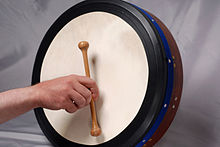Brief history of Bodhran – An Overview
The bodhran is a frame drum made of either wood or metal with stretched-on skin covering it – not just used for Irish music! However, this versatile instrument also serves great as an instrument in Scottish folk and rock music performances.
Traditional performances of the bodhran involve various techniques for playing its back hand to achieve different sound qualities and pitch qualities by applying pressure to its head in different amounts.
Origins
The exact origins of the bodhran drum are difficult to ascertain, yet some indications point towards its usage as a musical instrument in Ireland for at least 100 years. Early 20th-century mentions and uses indicate its usage both musically and ritualistically until sometime around 1960.
Historically, the bodhran has long been linked to St Stephen’s Day when used in a ritual known as ‘Hunting of the Wren’. Irish warriors used this practice as a means of revenge against anyone they believed had betrayed Saint Stephen and hunted wrens on St Stephen’s day to try and exact revenge for its treachery.
Sean O Riada revolutionized its use as a mainstream musical instrument during his work in the 1960s, leading many renowned Irish traditional musicians like Johnny McDonagh and John Joe Kelly to develop new playing techniques on it that expanded its musical vocabulary and ensured it found its place within contemporary music.
Construction
Traditional Bodhrans were constructed using goat skin stretched across a circular wooden frame, but today they can be highly intricate musical instruments carefully built and designed to produce their desired sounds.
Bodhrans can be found throughout Ireland and Scotland as well as many other parts of the world, making them a favorite percussion instrument used at folk sessions and ensemble performances.
The name ‘bodhran” derives from Irish Gaelic meaning “deaf”, although its definition encompasses other connotations: for instance ‘ni hinnte ata an guth bodhar”, referring to dull sound produced by calves; quality of misty or murky water bodies, etc.
Bodhran is also used in modern Scottish, where its meaning has expanded to encompass ‘dildurn’ – bothered, confused, annoyed or troubled.
Sounds
The Bodhran is one of the most beloved Celtic drums, popularly used in traditional Scottish and other musical traditions. Consisting of a frame drum covered with stretched skin over an unbowed circular wooden frame, its name derives its popularity.
There are various techniques for playing a bodhran, depending on its style and player. A hand style utilizes the knuckles for rhythm; there is one-sided and two-sided stick styles;
As a starting point for learning the bodhran, purchasing a kit may be the ideal way to begin learning. These kits typically contain a cipin or tipper as well as books and DVDs that will guide your progression as an artist. When choosing your instrument it should feel secure without dropping and provide enough maneuverability so you can play freely and comfortably.
Techniques
The Bodhran is an ancient instrument which has become immensely popular with musicians worldwide. Producing low, staccato sounds, it serves as the basis of many forms of traditional Irish music.
This humble frame drum can be found across cultures all around the globe and its exact origins remain unclear; most experts speculate that its inspiration comes from tambourines commonly found in southern continental Europe.
A bodhran is composed of wood and goat or cowhide skin stretched over its wooden frame and secured using tacking or glueing techniques. Traditionally, one or more crossbars within the frame were used to hold onto this skin – these days this practice is less prevalent among modern bodhrans.
Styles
Traditionally, the bodhran is a circular frame drum covered with goat skin. Nowadays they come in all sorts of sizes from small to large.
The bodhran first gained widespread acclaim during the folk revival in the 1960s. Sean O Riada of Ceoltoiri Chualann first introduced it to audiences.
O Riada used the bodhran as the focal point of his band’s sound, elevating its status and making it part of their signature sound.
Since then, bodhran playing has grown and transformed into a sophisticated art form, exploring all of its musical potential. Some bodhran players even incorporate techniques from other drumming traditions into their playing style.

